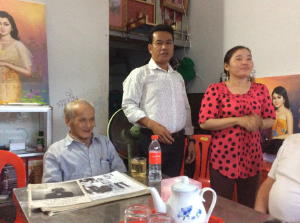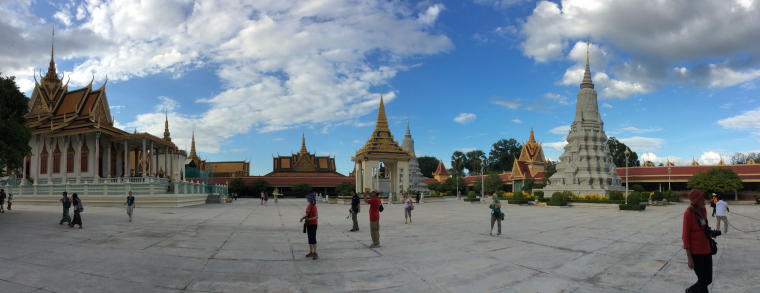|
December 7, 2015
After breakfast we had a 1-1/2 hour flight from Vientiane, Laos
to Phnom Penh, Cambodia. We were met by our local guide, Leng, and
given some background information about Cambodia. It is the smallest
country in SE Asia, about the size of New York State. There are
about 15 million people living in Cambodia, most of them farmers.
90% of the people are Khmer. The rest are Chinese, Vietnamese, etc.
Chinese influence is very strong, especially in the business sector.
Phnom Penh is the capital with about 2 million people. The French
ruled Cambodia from 1863-1953 so there is considerable French influence
in the architecture of the buildings in the city. Cambodia is a
constitutional monarchy with a king that is elected every 5 years.
But the king has no power - he is just a beloved figurehead. This
is a communist country with limited freedoms, especially of speech.
90% of the people are Buddhist but most ethnic minorities practice
animism.
 When
we got off the plane, the heat really hit us. It was 93 degrees
with 46% humidity. Quite a change from Laos's mid 70's. We were
driven to the Royal Palace where the current king still lives. The
palace was opened in 1870. It is a large complex and we visited
3 of the important buildings. When
we got off the plane, the heat really hit us. It was 93 degrees
with 46% humidity. Quite a change from Laos's mid 70's. We were
driven to the Royal Palace where the current king still lives. The
palace was opened in 1870. It is a large complex and we visited
3 of the important buildings.  The
first was the Throne Hall which is where the king's coronation takes
place as well as important official receptions. It contains the
Royal Throne. We were not allowed to take photos of the inside of
the hall, but looking inside it was very golden! The
first was the Throne Hall which is where the king's coronation takes
place as well as important official receptions. It contains the
Royal Throne. We were not allowed to take photos of the inside of
the hall, but looking inside it was very golden!
The second building we visited was the Silver Pagoda. It draws
its name from the more than 5000 silver tiles that cover its floor.
Inside are 1650 Buddhas donated by the royal family, including a
beautiful golden Buddha and an emerald Buddha made of Jade. The
king still comes here to pray. Again no photos were allowed inside.
The final building was the Full Moon building which houses the
royal gear, including the coronation dress, swords, etc. (No photos).
December 8, 2015
 We
started the day with a visit to a school for the arts. Children
from the age of 5 can attend classes in native dance, painting and
music. This was opened in 2013 through a grant from Japan and is
free to students. We watched performances of some traditional folk
dances by the students. We
started the day with a visit to a school for the arts. Children
from the age of 5 can attend classes in native dance, painting and
music. This was opened in 2013 through a grant from Japan and is
free to students. We watched performances of some traditional folk
dances by the students.  The
"volunteers" from our group were invited to try on traditional
clothing and participate in dances. Fred was one of the volunteers. The
"volunteers" from our group were invited to try on traditional
clothing and participate in dances. Fred was one of the volunteers.
 From
the school we went to the Choeung Ek Genocidal Center, also known
as the Killing Fields. Without going into the detailed history of
the start of the Khmer Rouge, and their leader Pol Pot, let's just
say that between 1975 and 1979, more than 3 million Cambodian people
were tortured and killed. Pol Pot's goal was to eliminate all dissidents
and purge the country of anyone who could become a dissident like
teachers and other intellectuals. In fact, if you wore glasses,
you were suspect. In addition, everyone in Phnom Penh was forced
to evacuate the city and were sent to work in the rice fields with
no pay and little food. Many died of starvation. From
the school we went to the Choeung Ek Genocidal Center, also known
as the Killing Fields. Without going into the detailed history of
the start of the Khmer Rouge, and their leader Pol Pot, let's just
say that between 1975 and 1979, more than 3 million Cambodian people
were tortured and killed. Pol Pot's goal was to eliminate all dissidents
and purge the country of anyone who could become a dissident like
teachers and other intellectuals. In fact, if you wore glasses,
you were suspect. In addition, everyone in Phnom Penh was forced
to evacuate the city and were sent to work in the rice fields with
no pay and little food. Many died of starvation.  The
Killing Field we visited is one of 300 mass grave sites in the country.
It was found and excavated in 1988. The bones, skulls and clothing
found in the mass graves have been placed in a 19 story memorial
stupa. As we walked around the site, we could see fragments of bone
and pieces of clothing on the ground. The
Killing Field we visited is one of 300 mass grave sites in the country.
It was found and excavated in 1988. The bones, skulls and clothing
found in the mass graves have been placed in a 19 story memorial
stupa. As we walked around the site, we could see fragments of bone
and pieces of clothing on the ground.
 In
the afternoon we visited the Genocide Museum which was formerly
known as S21. It was here that the prisoners were taken and tortured
into confessions of treason to the Khmer Rouge. Each prisoner was
photographed and many of their pictures were hanging in the museum.
This is a picture of one of the 4 buildings of S21, all housing
prison cells. In
the afternoon we visited the Genocide Museum which was formerly
known as S21. It was here that the prisoners were taken and tortured
into confessions of treason to the Khmer Rouge. Each prisoner was
photographed and many of their pictures were hanging in the museum.
This is a picture of one of the 4 buildings of S21, all housing
prison cells.
In 1979, Vietnamese troops invaded and removed Pol Pot from power.
There were only 7 survivors from S21. One is still living and we
were fortunate to be able to visit him and talk to him about his
life and time at S21. To
get to his home, we took a 45 minute ride in a remok, the Cambodian
version of a tuk tuk, a 3 wheeled motor rickshaw. This was an E
ticket ride as it was during rush hour. Cars, motor bikes, bicycles
and busses all fought for the same space on the road as the remoks.
No traffic lights, no stop signs, just merge in and go. To
get to his home, we took a 45 minute ride in a remok, the Cambodian
version of a tuk tuk, a 3 wheeled motor rickshaw. This was an E
ticket ride as it was during rush hour. Cars, motor bikes, bicycles
and busses all fought for the same space on the road as the remoks.
No traffic lights, no stop signs, just merge in and go.
 The
man on the left is the survivor of S21. He is now 72 years old.
His granddaughter is on the right and our guide and interpreter,
Leng, is in the middle. The reason he survived is that he was a
very fine artist and the Khmer Rouge asked him to paint portrats
of the leaders. What an amazing story and an amazing man. The
man on the left is the survivor of S21. He is now 72 years old.
His granddaughter is on the right and our guide and interpreter,
Leng, is in the middle. The reason he survived is that he was a
very fine artist and the Khmer Rouge asked him to paint portrats
of the leaders. What an amazing story and an amazing man.
This was a very sobering and emotional day, much like viewing the
gas chambers from the Jewish holocaust. But it was also extremely
interesting to learn about this piece of history. It was also well
documented in the movie, "The Killing Fields".
To view more photos from our trip to Phnom Penh, please go to Phnom
Penh Photo Gallery. To read about the next place we visited,
go to Sean Reap Newsletter.
Home
Locations Visited Photos Map
Contact Us
|
